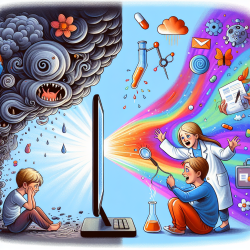Introduction
Recent research has highlighted the significant impact of prenatal environmental factors on neurodevelopmental outcomes, particularly in children with Autism Spectrum Disorder (ASD). A study titled "Prenatal air pollution influences neurodevelopment and behavior in autism spectrum disorder by modulating mitochondrial physiology" provides compelling evidence on how prenatal exposure to air pollution, specifically fine particulate matter (PM2.5), affects neurodevelopment and behavior in children with ASD. This blog aims to explore the findings of this research and discuss how practitioners can leverage these insights to enhance therapeutic interventions for children.
The Research Findings
The study investigated the role of mitochondrial physiology in mediating the effects of prenatal air pollution on neurodevelopment and behavior in children with ASD. The researchers measured mitochondrial function using the Seahorse XFe96 analyzer and assessed neurodevelopment through the Vineland Adaptive Behavior Scale, while behavior was evaluated using the Aberrant Behavior Checklist and Social Responsiveness Scale.
The findings revealed that prenatal exposure to PM2.5 influenced mitochondrial respiration during childhood, with distinct patterns observed in children with and without neurodevelopmental regression (NDR). Specifically, mitochondrial respiration was positively correlated with PM2.5 exposure in children with NDR, while a negative correlation was observed in those without NDR. These results suggest that prenatal air pollution may induce long-term changes in mitochondrial physiology, which in turn affects neurodevelopment and behavior.
Implications for Practitioners
Understanding the complex interplay between environmental factors, mitochondrial function, and neurodevelopmental outcomes is crucial for practitioners working with children with ASD. Here are some practical steps practitioners can take based on the research findings:
- Incorporate Environmental Assessments: Consider environmental factors, such as prenatal air pollution exposure, when assessing children with ASD. This can help identify potential risk factors and tailor interventions accordingly.
- Focus on Mitochondrial Health: Implement strategies to support mitochondrial function, such as nutritional interventions and lifestyle modifications, to potentially mitigate the effects of environmental stressors on neurodevelopment.
- Promote Early Intervention: Early identification and intervention for children with a history of NDR can be crucial in improving outcomes. Practitioners should be vigilant in monitoring developmental milestones and provide targeted support when needed.
- Encourage Further Research: While this study provides valuable insights, further research is needed to fully understand the mechanisms by which prenatal air pollution affects mitochondrial function and neurodevelopment. Practitioners can contribute to this research by participating in studies and sharing clinical observations.
Conclusion
The study underscores the importance of considering environmental factors, such as prenatal air pollution, in understanding and addressing neurodevelopmental disorders like ASD. By focusing on mitochondrial health and promoting early intervention, practitioners can play a pivotal role in improving outcomes for children with ASD. For those interested in delving deeper into the research, the original paper can be accessed through this link: Prenatal air pollution influences neurodevelopment and behavior in autism spectrum disorder by modulating mitochondrial physiology.










